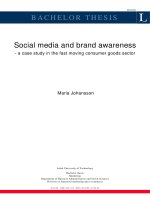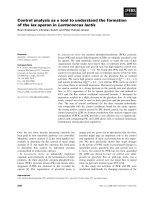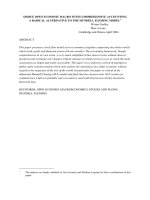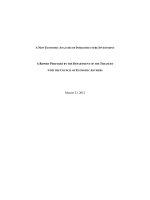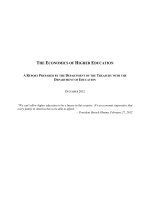ENVIRONMENTAL ACCOUNTING - A TOOL USED BY THE ENTITY FOR DETERMINING ENVIRONMENTAL COSTS docx
Bạn đang xem bản rút gọn của tài liệu. Xem và tải ngay bản đầy đủ của tài liệu tại đây (192.49 KB, 11 trang )
Annales Universitatis Apulensis Series Oeconomica, 12(1), 2010
207
ENVIRONMENTAL ACCOUNTING - A TOOL USED BY THE ENTITY FOR
DETERMINING ENVIRONMENTAL COSTS
Nicolae Todea
1
Ionela Cornelia Stanciu
2
Ana Maria Joldoş (Udrea)
3
ABSTRACT: This paper wants to make a fundamental contribution to current and recently started a
debate in the accounting profession and beyond. Internationally, the accounting profession, influenced
by a variety of views and broader contextual forces, began to really take into account how
environmental regulation of accounting. Historically speaking, the accounting was limited, most often
in his reflections on the resources represented by property and financial entities. This has become less
appropriate, being left out of accounting reflecting the "costs" important, such as environmental,
social, etc. Which were not present in the financial statements of entities, it is because entities do not
"pay" anything for the environment, and rather less on social issues. This does not mean that society as
a whole; do not support these "costs". The emergence of environmental accounting dating back to
1970, interest in this area increased considerably, from managers to give greater importance to
environmental issues.
Key words: Environmental Protection, Environmental accounting, Environmental costs, Protection
JEL codes: M41, O13
Introduction
Accounting is required to submit various types of user information on the financial position and
performance of entities in the management of resources at their disposal. In recent decades a growing
number of entities give great importance to environmental issues and their reflection by accounting,
either under the influence of administrative regulations or because of their information needs. In certain
circumstances, for certain fields, they can have a significant impact on the financial statements, and that
of their users. Green accounting has been around for two decades. As in all cases, environmental
management accounting is a tool to inform managers about the environmental costs, to quantify the
environmental effects of the entity.
Research Methodology
The methodology is a complex word (concept), etymologically composed of method’s and
logos which mean "method" and "science", in Greek, and free translation "science method", the science
of conception, choice and use of method in the investigation process of economic phenomena. The
research methodology is the theory and practice methods, an activity that is studying the essence,
nature, status, definition, classification, etc. the construction of explanatory models.
The need for scientific research in accounting is particularly important today, more than that
pluridisciplinarity in accounting research is necessary and sometimes profitable. Scientific research is
1
University 1 Decembrie 1918 Alba Iulia, Nicolae Iorga Street, no.11-13,
2
University Valahia Targoviste, Lt. Ion Stancu Street, no. 34-35,
3
University Valahia Targoviste, Lt. Ion Stancu Street, no. 34-35,
Annales Universitatis Apulensis Series Oeconomica, 12(1), 2010
208
necessary to seek and find solutions or answers to immediate problems and to achieve reasonable
theorizing issues to the environmental accounting, the expenditure of the environment, reporting. The
main objectives considered in preparing this article consisted of a stage presentation of knowledge in
the field of environmental accounting, presentation of concepts related to the concept of environmental
expenses and costs, identification of different criteria for the classification of environmental costs,
presentation of specific accounting treatment of environmental expenditure, presentation of
environmental costs in Romania for the years 2007 and 2008.
The scientific approach is based on information from literature and specialized national
European and international practice regarding environmental accounting and environmental specific
treatment costs. In this article we used methods of research like documentation, comparison, analysis,
synthesis, in order to achieve the proposed objectives.
The current state of knowledge in the field of environmental accounting
Environmental issues have found a reflection in the accounts only in the last part of the
twentieth century. The chronology of important developments in environmental accounting and
environmental issues reflected in the accounts we find at Ienciu (2009) which presents the following
rhythms:
→ Period 1971-1987: represents the beginning of the first environmental accounting research due to
the importance that begins to gain this area. The first period takes into account the literature in this field
through studies treating social and environmental accounting in the same way. Since the early 80s,
surveys suggest that the separation of environmental accounting and social accounting is starting, due
to increased interest in environmental reporting compared to the social. Also in this period begin to
appear accounting books dealing with aspects of social and environmental accounting. According to
research from this period, environmental auditing and environmental management accounting were not
treated separately. As a first step in the development of environmental accounting the articles published
on this subject have been in a small number, just like the regulations regarding environmental
accounting.
→ Period 1988-1994: the problem of environmental accounting is becoming an area of interest. In this
period of increased interest of researchers for this area, managers and even accountants begin to pay
attention to the problem of environmental accounting. It also increases research in environmental
accounting terms at the expense of research on social accounting. In this period, the concepts of
sustainability and environmental audit begin to interest the users. There were a number of books and
articles that dealt with the environmental accounting, environmental accounting showing the state of
knowledge both within universities and in the accounting. The progress in environmental accounting
regulations is slow, but much faster in comparison with that of social accounting.
→ Period 1995-2001: environmental accounting at both theoretical and practical level starts to address
on a large scale especially in developed countries. The number of studies in this period begins to grow;
this period can be called "the cornerstone" of accounting environment. Sub domains of environmental
accounting begin to develop, such as environmental costs, environmental management accounting and
environmental auditing. The concept of environmental audit occurred in the USA at the beginning of
the ’80 for evaluating ecological performances of some units in the oil field and chemical industry. So
as to avoid the payments incurred by environmental pollution, buyers systematically proceeded to
acquisitions from the units that implemented environmental protection policies (Beţianu Leontina et all,
2008). Environmental accounting researchers are beginning to give greater importance to this area,
begin to increase significantly the number of studies, environmental reports of remain the main sub
domain researchers treated. This sub domain begins to interest due to the implementation of standards
for environmental management, which contain a part of the audit or verification.
Annales Universitatis Apulensis Series Oeconomica, 12(1), 2010
209
→ Period 2002-present: there is a widening of this area of research in numerous developing countries
including Romania. At the international level are issued guidelines on reporting environmental
information and regulations appearing in the accounting environment. The number and quality of
articles on environmental accounting continues to grow. Year 2002 is the year that in Romania the
conceptual studies are beginning to appear. Studies in environmental accounting are becoming more
numerous, more extensive, outstanding contributions to the development of this field of research have:
C. Deegan, O'Donovan, Freedman and Stagliano, Cormier, Möbus, Gray, Chatterge, Aerts and Cornier.
Regarding the Romanian researchers, we include here the study by Lungu (Lungu et all, 2008), which
proposes "new approach" for corporate reporting and report of social and environmental information.
In Romania, there are studies of authors: Caraiani, Dumitrana, Jianu Tăbără, and Nuţă, Ienciu, Cenuşă,
which present the environmental accounting as an system composed of three parts: the reporting, the
management and the environmental audit. Environmental management accounting experiences a
separate development, both in terms of published studies and the quality and diversity of concepts and
theories discussed. In Romania, there are theoretical papers which treat environmental costs
(Dumitrana, 2005), analysis of the product life cycle (Creţu, 2004), environmental performance and its
implications on the financial performance of the entity (Creţu, 2004; Caraiani, 2007; Bonaci and
Ienciu, 2007). The environmental audit is treated increasingly more in this period, with the first work in
Romania dealing with this problem (Borza, 2007). Involvement of Romania’s accounting in the
business of environmental protection is even stronger with the entry into force on January 1, 2010 of
the Order 3055/2009 for approving the Accounting Regulations in accordance with European
directives, so in the chart of accounts, a new account is inserted, account 652 "Expenditure on
environmental protection. With this account are kept environmental protection expenditure recorded in
the relevant period, for example, environmental taxes paid, and the certificates of emissions of
greenhouse gases effect purchased.
From the presented it results that research into environmental accounting have come to the
forefront of accounting research, outpacing other chapters, such as social accounting, given the
importance of environmental issues on the community. Environmental reports remain an area of
interest for researchers, but other research subfields also have interest from researchers, namely,
environmental management accounting and environmental auditing.
Accounting involvement in environmental protection activities
Constant degradation of the environment and the growing number of environmental disasters
has caused environmental problems to have a greater importance. Integrating environmental issues in
life requires entities to consider them at economic and legal, accounting, financial, and technical level
(Lafontaine, JP, 2002). In economic terms taking into account environmental parameters in the cost of
services or products, enable entities, on the one hand to rationalize energy consumption of natural
resources, achieving substantial savings and, secondly, to meet the requirements of environmental
compliance consumer health. Legal consideration of environmental risks is required to undertake the
responsibility of the entity. This responsibility rises from failure to comply with environmental
legislation and may result in administrative sanctions, civil and / or criminal. From the accounting and
financial point of view, recording of environmental costs and determining environmental costs
generated by the entity and related financial disclosure is way of evaluating the performance of work
(Beţianu L., 2008).
The question is: Which department of the entities would be most suitable for the management of
environmental information? A certified public accountant from Bulgaria, Dimiter Jeliazkov, in a study
called "Accounting can and should be involved in environmental protection”, says that" the only
subdivision that could meet this challenge, is the accounting department, reflected as financial and
Annales Universitatis Apulensis Series Oeconomica, 12(1), 2010
210
economic condition of the entity and changes of these conditions in the most comprehensive and
multilateral way "(D. Jeliazkov, 2009, p. 52). He proposes to develop an international standard for
environmental accounting, to implement a uniform solution across the globe titled "Reporting on
environmental regeneration" aimed at determining the organization and implementation of reporting on
environmental regeneration within the entities that pollute, and those who consume natural resources.
In Bulgaria there is such a standard which deals with environmental issues and lines of coordination to
be put into application, but did not become operational due to lack of interest from both, the entities
that pollute, and the competent governmental bodies.
As we have noted, the involvement of Romania in accounting for environmental protection
work has found a reflection with the accounting regulations in accordance with European Directives,
applicable from 1 January 2010, which included the chart of accounts 652 "Environmental Protection
Expenditure. In our opinion only this account is not enough, because you can’t separate elements that
reflect the cost of materials, wages, etc.
Environmental accounting treatment applicable to environmental costs
No matter what their activity is, entities must be within the general rules of an open democratic
society; one of the most important rules of democracy is transparency. Transparency requires activity
"in daylight" or "sight". From this point of view, the entities cannot hide behind secrecy, at least some
of their aspects. They are forced to provide information about aspects of their activities in order to
allow control of the company on these issues (Todea N., 2009). From the aspects of the entities
activities are detaching the aspects related to the economical and financial activity. Such aspects
concern how to obtain funding necessary to conduct normal business conditions, the use of these funds,
their efficiency, entities providing such information to various categories of users, including public, the
result of the existence and operation of an economically information system. The idea is drawn from
the international accounting standards, namely IFRS which show that "the objective of financial
statements is to provide information about the financial position, financial performance and changes of
the financial position of an entity; this information is useful to a broader sphere of users in making
economic decisions "(IFRS, 2007).
An important aspect of environmental accounting refers to the recognition of the environmental
costs. Obviously this requires defining environmental costs. Such a definition is found in international
and European accounting rules. According to the IASB and the FASB, environmental costs are
determined environmental costs, which resulted in a benefit that has expired and which is detailed
along with income in the income statement.
Recommendation of CE, 453/2001, defines environmental costs as "those costs to prevent,
reduce or recover damages that the entity has caused or is likely to cause on the environment as a result
of its activities. These include prevention, elimination or reduction of waste and wastewater, air
emissions, treatment of contaminated soil, groundwater, noise and vibration levels, the landscape
changes, research and innovation of products and cleaner production processes, control of
environmental quality".
Canadian Institute of Chartered Accountants (CICA, 1998) present environmental costs as
environmental costs which generate, directly or indirectly benefits of the current period, the period in
which they occur, providing a series of details in this regard. Thus we have:
→ Costs generating direct benefits of the current period: expenditure on waste treatment and
monitoring, recovery or cleanup costs associated with current business of the entity;
→ Indirect costs which generates the current period's benefits: the costs of administrative activities,
compliance, evaluation and environmental audit, courses and seminars related to staff training on
environmental protection;
Annales Universitatis Apulensis Series Oeconomica, 12(1), 2010
211
→ Costs regarded as losses for the period: costs that do not generate future economic benefits that
cannot be capitalized (costs related to research performed to design cleaner products and processes,
costs of participation in recycling programs), costs related to activities undertaken but that generated a
benefit that expired (cost recovery and cleaning of polluted land), costs that have not generated any
benefit (fines, penalties, failure to comply with environmental regulations and legislation).
As shown in the list above, we can see that the costs of penalties and fines for failure to comply
with environmental legislation are not included in the environmental category. In our opinion they
should be part of the environmental costs, at least in terms of the sanctioned entity.
The National Institute of Statistics, at the macroeconomic level, reflect environmental costs of
financing environmental flows and include payments for economic activities aimed at production of
specific services to prevent, reduce or control environmental damage. They are grouped into:
investment and running costs which in turn include internal current expenditure (salaries and social
security contributions, consumption of raw materials, fuel, energy, water and other auxiliary materials,
expenses for research and development, training, information) and current external costs (costs of
environmental protection services purchased from third parties and environmental taxes paid).
According to the sources, expenditure in this category in 2007 and 2008 in Romania is as follows:
Table no. 1
Expenditure for environmental protection sectors and categories expenditure
in 2007 and 2008
- Thousand lei-
Which
Current expenditure
Total expenses
Investment
internal external
Sectors
2007 2008 2007 2008 2007 2008 2007 2008
Non-specialist
producers
4.516.525 2.743.422 1.550.499 1.329.980 2.153.762 913.847 812.264 499.595
Forestry,
logging and
related services
143.087 36.976 117.024 12.547 23.799 15.892 2.264 8.537
Mining and
quarrying
1.336.006 635.420 292.874 380.742 771.532 120.174 271.600 134.504
Manufacturing 1.873.122 1.478.540 788.268 667.734 750.615 550.167 334.239 260.639
Supply,
electricity,
gas and hot
water
818.851 468.199 312.143 240.773 354.449 153.351 152.259 74.075
Construction 345.459 124.287 40.190 28.184 253.367 74.263 51.902 21.840
Specialized
producers
8.328.234 7.039.354 1.716.516 1.048.084 5.637.738 5.487.074 973.980 504.196
Public
Administration
3.633.332 2.914.520 1.635.463 1.296.891 939.424 867.226 389.368 224.969
Source: www.insse.ro
In 2008, expenditure on environmental protection at national level was approximately 14.3
billion lei, representing approximately 2.8% of GDP compared to 2.7% in 2007. The share of
environmental investment specialist producers represented 35.0% of total investments, followed by
public administration (33.4%) and non-specialist producers (31.6%). In manufacturing have achieved
Annales Universitatis Apulensis Series Oeconomica, 12(1), 2010
212
41.5% of the total non-specialist producers, while the mining industry in 2008 absorbed 29.6% vs.
23.2% in 2007, and the production and supply of electricity and heat, 18.1%.
Table no. 2
Environmental protection expenditures in environmental areas and categories of producers
in 2007 and 2008
- Thousand lei-
Total
Manufacturers
non-specialist
Manufacturers
specialized
Public Management
Environmental
Domains
2007 2008 2007 2008 2007 2008 2007 2008
Air Protection
1.619.272 1.130.353 1.242.606 803.990 55.984 44.614 320.682 281.749
Water Protection
3.508.767 2.697.415 788.120 642.085 1.352.751 1.002.417 1.367.896 1.052.913
Management
Waste
8.927.767 6.735.353 1.072.457 479.853 6.778.036 5.843.427 1.077.274 412.073
Soil and
Groundwater
760.807 957.022 619.360 179.375 65.817 27.468 75.630 750.179
Fighting
noise and
Vibration
32.594 92.134 8.900 19.093 3.165 19.728 20.529 53.313
Protection
natural resources
and conservation
biodiversity
212.147 259.676 141.974 117.202 21.900 39.384 48.273 103.090
Other areas
Environment
1.416.737 825.343 643.107 501.824 50.582 62.316 723.048 261.203
Source: www.insse.ro
In environmental areas, specialist producers recorded the largest expense for waste management
(approximately 76% of total expenditure for this area). For water protection, the largest expenditure
was made by the government (39.0%), while for air protection higher costs were recorded in 76.7%
non-specialist producers.
Specialist producers recorded in 2007, the largest expenditure in the "waste management"
(83.0%), while for non-specialist producers, the costs have been directed primarily to the "air
protection" (29.3%). Government has made the biggest expenses on the "water protection" (36.1%).
The accounting treatment of environmental expenditure is influenced by tax legislation in force.
Romania Tax Code treats the expenditure for environmental protection and resource conservation as
deductible expenses. Thus, entities will increase pollution prevention activities where the costs of these
activities are deductible. Some expenses such as fines for violation of environmental regulations and
certain remedial costs are not tax deductible. Entities will seek to reduce costs and fines and penalty tax
deductible and will increase the number of environmental activities, which makes the tax treatment to
be an important tool in changing attitudes towards environmental entity.
Annales Universitatis Apulensis Series Oeconomica, 12(1), 2010
213
The potential of environmental management accounting to reflect environmental costs
The concepts of "General Accounting" and "Analytical Accounting" are recognized by experts
for a long time. Today, the practice tends to enshrine the names of "Financial Accounting" and
"management accounting" or "managerial accounting".
Financial accounting records flows of an economic entity and its environment, expressed in the
published financial statements, is governed by standards and regulations, providing information to
external users. Financial accounting includes most environmental costs along with other costs, and thus
environmental costs cannot be identified. To reduce pollution, some entities granted significant sums.
In some cases they are easily identifiable, but environmental costs are much higher than those relating
to pollution prevention and control, and are often included in hidden costs. Management accounting is
an "internal accounting" providing information to internal users. As in all cases, environmental
management accounting is a tool to inform managers about the environmental costs, to quantify the
environmental effects of the entity. It appeared as a result of increasing pressure on the entity's
management to reduce costs and minimize environmental impact activities (United Nations for
Sustainable Development Division, 2003).
Unlike financial accounts using only monetary standard, management accounting does not
resume only to the monetary standard it presents information in natural standard.
There are many definitions of environmental management accounting, but from an accounting
perspective is important to see the offer of information on the entity's environmental performance made
available to users. IFAC defines environmental management accounting as economic and
environmental performance management by developing and implementing appropriate systems and
practices on the environment. Although this includes reporting and auditing work in some entities,
management accounting environment refers to the lifetime costs to determine total costs and benefits
assessment strategic environmental management planning.
Department of Sustainable Development defines environmental management accounting as the
accounting where the information given is used for internal organization of the decision making
process, and the procedures taken for internal decisions include quantitative information on material
and energy consumption, their flows, waste generated and monetary information on costs, savings and
revenues on an activity with potential environmental impact.
Australian Environment Agency defines environmental management accounting as the
identification, collection, analysis, internal reporting and using information on material and energy
flows, environmental costs and other costs necessary for decision making within an entity.
From our point of view, environmental management accounting is a mechanism in which there
are both financial and non-financial information, using tools such as calculation of environmental costs
or environmental performance evaluation. Basically we are dealing with a blend of environmental
management, management accounting, and the result providing information to internal users in order to
take decisions regarding the environmental impact of the entity.
In some works, from the fact that this module called environmental management accounting
provides financial and non-financial information, it appears the possibility of the division of
environmental management accounting for money (Monetary Environmental Management Accounting -
MEMA) and accounting environmental management in physical units (Physical Environmental
Management Accounting - PEMA).
Environmental management accounting in monetary units (MEMA) is used for internal
management decisions and aims to identify and treat costs and benefits arising from the impact it has
on the environment entity (Schaltegger and Wagner, 2005). With regard to his methods, MEMA is
based on traditional management accounting adapted to be applied to the environmental aspects of
Annales Universitatis Apulensis Series Oeconomica, 12(1), 2010
214
corporate activity. It focuses on environmental impact assessment expressed in monetary terms (cost of
fines for violation of the environment rules, investment in pollution prevention projects).
Environmental management accounting in physical units (PEMA) serves as a informational tool for
internal management decisions, using monetary data, expressed in physical units (kg, t, m, etc.).
There is a very eloquent structuring data provided by environmental management accounting
(EMA) and their application in so-called past and future-oriented tools:
Table no.3
Past and future oriented EMA tools
EMA
MEMA PEMA
Past oriented tools Future oriented tools Past oriented tools Future oriented tools
Annual environmental
expenditure or costs,
transition from
bookkeeping and cost
accounting
Monetary
environmental
budgeting and
investment
appraisal
Material, energy and
water
flow balances
Physical environmental
budgeting and
investment
appraisal
Calculating costs,
savings
and benefits of projects
Environmental
performance
evaluation and
indicators,
benchmarking
Setting quantified
performance targets
External disclosure of
environmental
expenditures,
investments and
liabilities
External environmental
reporting and other
reporting
to agencies and
authorities
Design and
implementation
of environmental
management systems,
cleaner production,
pollution
prevention, design for
environment, supply
chain
management, etc.
Source: United Nations Division for Sustainable Development, Environmental Management Accounting, New
York, 2001, p.18
Data provided by environmental management accounting (EMA) and can structure their
application in past and future-oriented tools:
Annales Universitatis Apulensis Series Oeconomica, 12(1), 2010
215
Table no. 4
Levels for the implementation of EMA
Accounting in Monetary Units Accounting in Physical Units
Environmental Management Accounting Conventional
Accounting
MENA PEMA
Other Assessment
Tools
DATA ON THE CORPORATE LEVEL
Conventional
bookkeeping
Transition of
environmental part
from
bookkeeping and cost
accounting
Material flow balances
on
the corporate level for
mass, energy and water
flows
Production planning
systems,
stock accounting
systems
DATA ON THE PROCESS/COST CENTRE AND PRODUCT/COST CARRIER LEVELS
Cost accounting Activity based material
flow cost accounting
Material flow balances
on the process and
product levels
Other environmental
assessments, measures
and evaluation tools
BUSINESS APPLICATION
Internal use for
statistics,
indicators, calculating
savings, budgeting and
investment appraisal
Internal use for
statistics,
indicators, calculating
savings, budgeting and
investment appraisal of
environmental costs
Internal use for
environmental
management systems
and
performance
evaluation,
benchmarking
Other internal use for
cleaner production
projects
and condensing
External financial
reporting
External disclosure of
environmental
expenditures,
investments and
liabilities
External reporting
(EMA statement,
corporate
environmental report,
sustainability report)
Other external reporting
to
statistical agencies,
local
governments, etc.
NATIONAL APPLICATION
National income
accounting by
statistical agency
National accounting on
investments and annual
environmental costs of
industry, externalities
costing
National resource
accounting
(material flow balances
for
countries, regions and
sectors)
Source: United Nations Division for Sustainable Development, Environmental Management Accounting, New
York, 2001, p.19
It results from the above quite clearly the ability of environmental management accounting to
reflect environmental costs that the entity is to prevent, treat or repair the damage it has caused to the
environment. This is achieved via accounts available. As for traditional accounting management for
each product or service work is necessary to calculate costs of production per unit of measure, and for
environmental management accounting should be made to calculate average costs per average sequence
performed on each sub domain environment. For example, with account 921 "core business expenses"
under traditional management accounting is analytically distinct record for each department and each
Annales Universitatis Apulensis Series Oeconomica, 12(1), 2010
216
product consumption of raw materials and supplies made with the new product, the salary costs of staff
involved in production, and in environmental management accounting would be detailed every activity
undertaken in order to know at any moment average costs for the work done by the entity.
Conclusions and proposals
Of the presented one can see that accounting development in recent years, were focused on
environmental accounting, accounting research in the field of environmental accounting have been and
continue to the detriment of social accounting research; environmental financial accounting,
environmental reporting continues to represent the principal interest in research in environmental
accounting, but we noticed a growing interest to other sub domains such as environmental management
accounting, environmental audit; in terms of research in Romania on environmental accounting, these
are still early but however it is noted an interest in this area.
Chart of accounts applicable to entities that do not contain separate accounts to reflect
environmental issues. Entities whose activities pollute should record separately the expenses incurred
for the purchase of machinery and equipment used for environmental protection, their depreciation,
with the salaries of staff involved in environmental protection, materials used and other environmental
costs.
Basically, as currently reflected, Romanian accounting techniques is not possible to separate
coverage of environmental issues in accounting. As opportunities for coverage of environmental issues
in accounting such as development plan accounts in the accounts of grade 2 and 3, by introducing new
accounts, chart of accounts is not having a limited character. Another possibility is the organization of
environmental management accounting, in this situation the development plan accounts are not
required but finding the appropriate method of calculation.
Neither the management accounting practice is not too rich in terms of coverage of
environmental issues; environmental costs are included along with other expenses. The only area where
there seems to be concern for environmental management accounting is the mining, because of its
complexities. At least at the legislative level, there is mandatory coverage of environmental costs in
accounting.
Given the intense process of normalization and standardization of accounting, it is noted that in
regard to environmental management and protection of it, efforts are made to a common representation
of such activities, the existence of standards governing environmental issues such as as for Bulgaria,
and Romania with the entry into force of the Order 3055/2009, makes itself felt in our accounting
involvement in covering environmental issues. Due to the fact that in Bulgaria there is an international
standard for environmental accounts entitled "Reporting on environmental regeneration," our proposal
is to develop in Romania such a standard that deals with environmental issues and lines of coordination
to be made in application.
The conclusion to be drawn is that we have to make the whole activity to be undertaken in full
harmony with the environment, ensuring sustainable development.
References
1. Beţianu, L., 2009. Calitate totală în contabilitatea mediului, Universităţii „Alexandru Ioan
Cuza” Publishing House, Iaşi.
2. Beţianu, L., Georgescu, I., 2008. Approaches of environmental information audit in annual
reports, Annales Universitatis Apulensis Series Oeconomica, no.10 (1).
3. Caraiani, C., Jianu, I., 2007. Contabilitatea verde – o perspectivă a schimbării în contabilitate,
Revista CECCAR, Partea I – a, nr. 4/2007.
Annales Universitatis Apulensis Series Oeconomica, 12(1), 2010
217
4. Cenuşă, L., 2008. Contabilitatea verde – un pas important spre o reală protecţie a mediului,
Revista CECCAR, nr. 2/2008.
5. Dimităr, J., 2009. Contabilitatea poate şi trebuie să fie implicată în protecţia mediului, Revista
Audit Financiar nr.12/2009; pp. 50-55;
6. Dumitrana, M., 2005. Contabilitate şi Informatică de Gestiune Journal, nr. 13-15/2005.
7. Gamini, H., 2005. Sustainable development and environmental accounting: the challenge to the
economics an accounting profession, Internationl Journal of Social Economics, vol.32.
8. Jahamani,Y. F., 2003. Green accounting in developing countries: the case of U.A.E. and Jordan,
Managerial Finance Journal, Vol. 29, Issue: 8.
9. Ienciu, A., 2009. Implicaţiile problemelor de mediu în contabilitatea şi auditul situaţiilor
financiare, Risoprint Publishing House, Cluj Napoca.
10. Lafontaine, J.P., 2002. Enseignement et management de l’information: le cas de la comptabilite
environnementale, XXIII congres de l’ AFC, Toulouse.
11. Maunders, K. T., Burrit, R. L., 1991. Accounting and Ecological Crisis, Accounting, Auditing
& Accountability Journal, Vol. 4 Issue: 3.
12. Perez, E.A., Ruiz, C., Fenech, F., 2007. Environmental management systems as an embedding
mechanism a research note, Accounting, Auditingand Accountability Journal, vol.20.
13. Schaltegger, S., 2004, Sustainability Accounting and Reporting - Fashion or Durable? 7th
EMAN conference on Sustainability Accounting and Reporting Lüneburg.
14. Schaltegger, S., Wagne, M., 2005. Current Trends in Environmental Cost Accounting – and its
interaction with eco-efficiency performance measurement and indicators, Eco-efficiency in
industry an science, vol.18.
15. Tabără, N., Horomnea. E., Nuţă, F. M., 2007. Dezvoltarea durabilă şi contabilitatea de mediu,
Revista Finanţe Publice şi Contabilitate, nr. 9/2007.
16. Todea, N., 2009. Teorie contabilă şi raportare financiară, Aeternitas Publishing House, Alba
Iulia.
17. Canadian Institute of Chartered Accountants, 1998. Examination of national standards and
regulations for environmental financial accounting
18. Environment and the OECD Guidelines for Multinational Enterprises: Corporate Tools and
Approaches Publication: Paris, OECD, 2005.
19. Ordinului 3055/2009 pentru aprobarea Reglementărilor Contabile conforme cu Directivele
Europene, Publicat în Monitorul Oficial al României nr. 766/10.11.2009.
20. United Nations Division for Sustainable Development, Environmental Management
Accounting, New York, 2001, available on-line at
21. www.insse.ro, accessed May 20, 2010.


